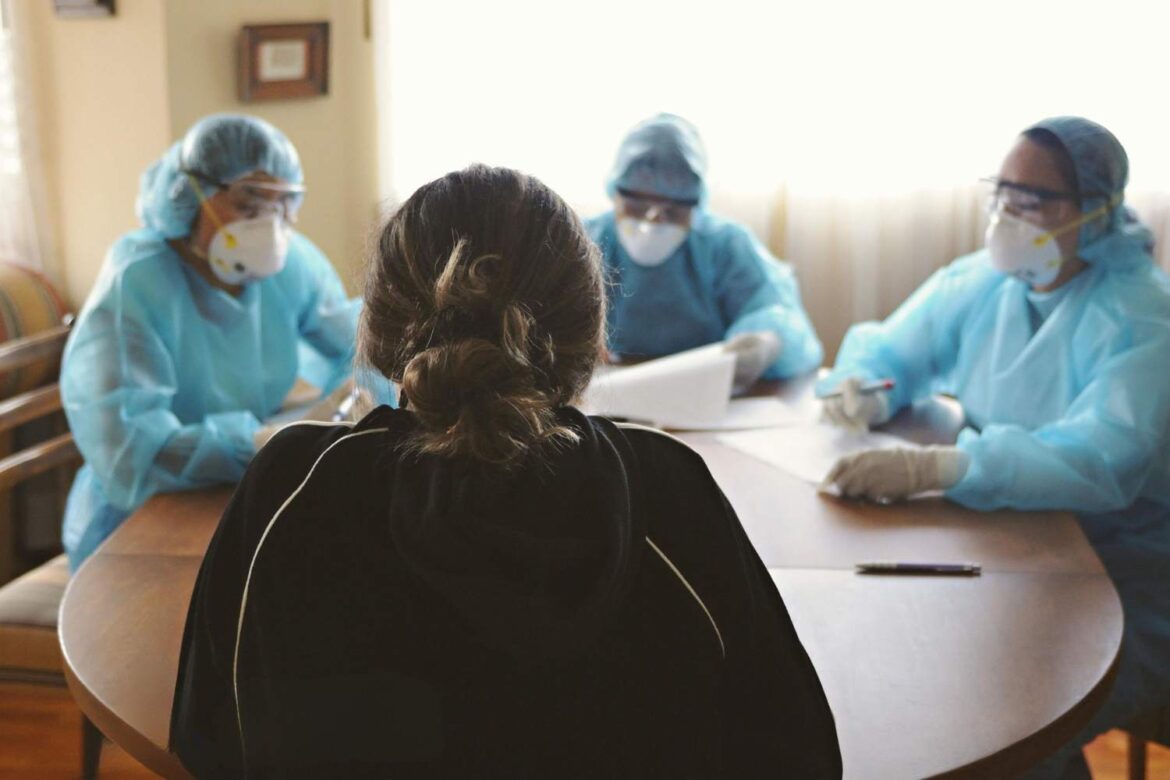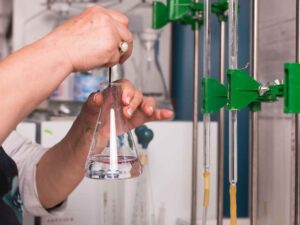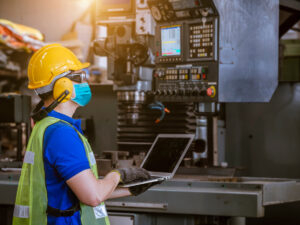
Definition of PPE
Personal Protective Equipment or (PPE) for short, refers to specialized protective clothing or equipment worn by an employee or researcher.. It is used to safeguard the employees, research materials, research animals, or biological products.
According to the Occupational Safety and Health Administration, “PPE is the equipment worn to minimize exposure to hazards that cause serious workplace injuries and illnesses. These injuries and illnesses may result from contact with chemical, radiological, physical, electrical, mechanical, or other workplace hazards”.
The Importance of PPE in Ensuring Worker Safety
PPE plays a critical role in reducing the risk of injuries and illnesses that can occur in various workplaces, from construction sites to laboratories. Its importance can be highlighted in several ways:
Preventing Injuries – In many industries, workers are exposed to dangerous conditions like falling objects, electrical hazards, chemicals, or extreme temperatures. PPE provides a barrier between the worker and these hazards, significantly reducing the likelihood of injury.
Health Protection – PPE is essential for protecting workers from long-term health problems. For instance, exposure to chemicals or loud noise can lead to chronic illnesses like lung disease or hearing loss. Respirators and ear protection can help mitigate these risks.
Compliance with Regulations – Employers are legally required to provide appropriate PPE under the Occupational Health and Safety Act. Failure to do so can result in fines and legal consequences.
Types of PPE and Their Functions
Each type of PPE serves a specific purpose. Here’s a breakdown of the most common types and their roles:
Head Protection – Hard hats are used to protect against falling objects, impacts, or electrical hazards. They are vital in industries like construction, manufacturing, and electrical work.
Eye and Face Protection – Safety goggles, glasses, and face shields prevent eye injuries from flying debris, chemicals, or molten metal. In jobs involving chemicals, welding, or machinery, eye and face protection is especially crucial.
Ear Protection – Employees exposed to high levels of noise (e.g., in factories, construction sites, or airports) should use earplugs or earmuffs to protect against hearing damage or loss.
Respiratory Protection – Respirators and masks protect workers from inhaling harmful dust, fumes, gases, or vapors. In industries like mining, healthcare, or chemical manufacturing, respiratory protection is vital.
Hand Protection – Gloves protect workers from cuts, burns, chemicals, or extreme temperatures. Different gloves are designed for different tasks e.g., chemical resistant gloves for chemical handling, cut-resistant gloves for construction, and insulated gloves for electrical work.
Body Protection – Coveralls, aprons, or jackets protect workers from hazards like chemicals, fire, or temperature extremes. These garments are used in industries ranging from chemical processing to welding.
Training and Awareness
Training and awareness are essential for ensuring the effective use of Personal Protective Equipment (PPE). It is not enough for workers to simply wear PPE; they must also understand how to use it correctly. Employers should provide comprehensive training on the proper use and fit of PPE, including when and how to use different types of equipment for various tasks. Additionally, workers should be educated on how to properly maintain and clean their PPE to ensure its longevity and effectiveness. It is also important to train workers on recognizing when PPE is damaged and needs replacement to avoid compromising their safety.
The Importance of PPE in Worker Safety: Industry-Specific Insights
Construction Industry – The construction industry is one of the most hazardous sectors, with workers exposed to risks such as falling debris, electrical hazards, heavy machinery, and dangerous heights. PPE in this industry is not only essential but mandatory.
Key PPE in Construction:
- Hard Hats: Protect against head injuries from falling objects, collisions, or accidental head impacts.
- High-Visibility Clothing: Helps ensure workers are visible to operators of heavy machinery and vehicles, especially in low-light conditions.
- Safety Boots: Steel-toed boots protect against foot injuries from falling objects and provide traction on slippery surfaces.
- Gloves: Used to prevent cuts, burns, and abrasions when handling materials or working with machinery.
- Eye and Face Protection: Safety goggles, face shields, or welding helmets shield against flying debris, chemicals, and intense light (from welding).
Compliance and Standards:
- Occupational Health and Safety Act require employers to provide appropriate PPE that is durable and properly maintained. Workers must be trained in using PPE and be provided with equipment that fits correctly to ensure optimal protection.
- Regular PPE audits and ensuring the integrity of the gear (e.g., replacing hard hats after impact) are crucial for ongoing worker safety.
Healthcare Industry – Healthcare workers face unique risks, including exposure to infectious diseases, hazardous drugs, bloodborne pathogens, and potential physical injuries. PPE is essential in preventing cross-contamination, protecting healthcare providers from infectious diseases, and ensuring patient safety.
Key PPE in Healthcare:
- Gloves: Protect against contamination from bodily fluids and pathogens.
- Masks and Respirators: N95 respirators or surgical masks prevent airborne transmission of viruses and bacteria, especially in high-risk settings like hospitals or during procedures.
- Gowns and Aprons: Used to protect the body from contaminants, particularly when handling patients or cleaning contaminated areas.
- Face Shields and Goggles: Provide additional protection to the eyes and face from droplets or splashes.
- Shoe Covers: Reduce the risk of spreading contamination from the floor to other areas of the healthcare facility.
Compliance and Standards:
- Healthcare PPE is governed by regulations from bodies such as the CDC (Centers for Disease Control and Prevention) and Occupational Health and Safety Act.
- In high-risk environments, such as during surgery or working in quarantine zones, healthcare workers must wear appropriate protective gear to comply with infection control standards.
- Training on the correct use, disposal, and maintenance of PPE is critical to prevent accidental exposure.
Manufacturing Industry – In manufacturing, workers deal with physical hazards such as heavy machinery, chemicals, extreme temperatures, and noise. PPE is essential to mitigate risks that could lead to injuries or health problems, such as musculoskeletal injuries, respiratory issues, or hearing loss.
Key PPE in Manufacturing:
- Hearing Protection: Earplugs or earmuffs are vital in noisy environments to prevent permanent hearing damage.
- Protective Gloves: Workers may wear cut-resistant, heat-resistant, or chemical-resistant gloves depending on the tasks at hand.
- Respirators: Used when working with chemicals, dust, or fumes that could cause respiratory issues.
- Safety Glasses: Protect eyes from flying debris, chemicals, or sparks.
- Aprons and Protective Clothing: Workers in areas with extreme temperatures or where exposure to chemicals is possible may wear protective clothing like flame-resistant garments or chemical aprons.
Compliance and Standards:
- Manufacturing plants must comply with the Occupational Health and Safety Act, ensuring workers wear appropriate protective gear depending on the task.
- Employers must conduct hazard assessments to determine what PPE is necessary for different tasks and ensure that PPE fits well and is properly maintained.
Oil and Gas Industry – The oil and gas industry is one of the most hazardous sectors, with risks including explosions, fires, exposure to toxic chemicals, and heavy machinery accidents. PPE plays a critical role in mitigating these risks, ensuring the safety of workers operating in extreme environments.
Key PPE in Oil and Gas:
- Flame-Resistant Clothing (FRC): Protects against burns from fires or explosions.
- Hard Hats: Essential for protection from falling debris or potential head injuries from machinery.
- Respirators: Protect workers from inhaling toxic gases, chemicals, or fumes.
- Safety Boots: Steel-toed boots prevent foot injuries, while anti-slip soles provide stability on slippery surfaces.
- Eye Protection: Goggles or face shields protect against flying particles, chemicals, and intense heat.
Compliance and Standards:
- The National Fire Protection Association (NFPA) and the Occupational Health and Safety Act set strict standards for PPE.
- Employers must regularly inspect and replace damaged PPE to ensure workers’ safety.
- Training on how to correctly use and maintain PPE is required to ensure its effectiveness in preventing injuries.
Mining Industry – Mining is a high-risk profession with numerous dangers, including cave-ins, exposure to toxic gases, dust inhalation, and accidents involving machinery. PPE is vital in protecting miners from both immediate hazards and long-term health issues.
Key PPE in Mining:
- Hard Hats: Protect miners from falling rocks and debris.
- Respirators and Dust Masks: Used to prevent inhalation of harmful dust and gases.
- Hearing Protection: Protects miners from permanent hearing loss due to constant exposure to loud machinery and equipment.
- Steel-Toed Boots: Protects the feet from heavy objects or machinery accidents.
- Protective Clothing: Flame-resistant and durable clothing to shield from burns and abrasions.
Compliance and Standards:
- Mining operations must comply with Mine Health and Safety Act.
- Regular safety checks, PPE maintenance, and proper fit are mandated to reduce the risk of injury or death.
Conclusion: The Critical Role of PPE in Ensuring Safety Across Industries
Personal Protective Equipment is an essential part of maintaining a safe work environment, regardless of the industry. Complying with safety standards and regulations not only helps in reducing the risk of accidents but also ensures that workers remain healthy and protected throughout their careers. Adhering to industry-specific PPE requirements, conducting proper training, and maintaining regular inspections of equipment are crucial components of a comprehensive workplace safety strategy. Proper use of PPE can prevent life-altering injuries and illnesses, creating a safer, more productive environment for everyone.
References:
- Amer, Samar. (2023). Personal Protective Equipment (PPE) 1. Available at: https://www.researchgate.net/publication/367561587_Personal_Protective_Equipment_PPE_1
- Chernin, E. (1988) The ‘Harvard System’: A mystery dispelled. Available at: http://www.uefap.com/writing/referenc/harvard.pdf (Accessed: 4 July 2016).
- Occupational Safety and Health Administration (OSHA). (n.d.). Personal Protective Equipment. U.S. Department of Labor. Available: https://www.osha.gov/personal-protective-equipment (Accessed 6th March 2025).








